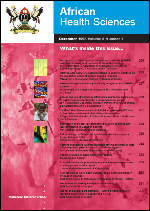
|
African Health Sciences
Makerere University Medical School
ISSN: 1680-6905
EISSN: 1680-6905
Vol. 15, No. 4, 2015, pp. 1200-1203
|
 Bioline Code: hs15165
Bioline Code: hs15165
Full paper language: English
Document type: Research Article
Document available free of charge
|
|
|
African Health Sciences, Vol. 15, No. 4, 2015, pp. 1200-1203
| en |
Bile acids cycle disruption in patients with nasopharyngeal carcinoma promotes the elevation of interleukin-10 secretion
Wang, Cheng-Shi; Liu, Shou-Hou; Peng, Jin; Tang, Chen & Zhu, Wei-Guo
Abstract
Background: Unclear pathogenesis existed for nasopharyngeal carcinoma.
Aims: to analyze the role of bile acids in the pathogenesis of nasopharyngeal carcinoma.
Methods: 20 healthy volunteers and 20 patients with nasopharyngeal carcinoma were enrolled between January 1st, 2013 and
December 31st, 2014. ESI-QTOF-MS analysis of serum was performed to find altered bile acids components. The biological
function of changed bile acids was investigated using in vitro experiment.
Results: Compared with healthy volunteers, the level of DCA and GDCA exhibited higher abundance in patients with
nasopharyngeal carcinoma (p<0.01). Furthermore, the biological function was investigated for the inhibition of DCA and
GDCA towards the secretion of IL-10 by CD4+CD25- T cells. Both DCA and GDCA significantly inhibited the secretion
of IL-10 by CD4+CD25- T cells. Furthermore, DCA+GDCA can show stronger inhibition towards the secretion of IL-10
than DCA and GDCA.
Conclusion: The inhibition of IL-10 secretion by elevated DCA and GDCA components in nasopharyngeal carcinoma
patients is the inducer for nasopharyngeal carcinoma.
Keywords
nasopharyngeal carcinoma; interleukin-10 (IL-10); pathogenesis; T cell; bile acids
|
| |
© Copyright 2015 - African Health Sciences
|
|
